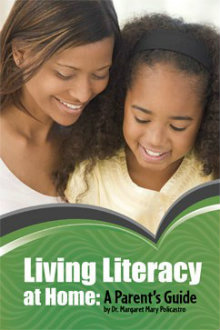A Rich Literacy Plan for Well-Resourced Parents
Living Literacy at Home: A Parent’s Guide
By Margaret Mary Policastro
(Capstone Press, 2017 – Learn more)

Margaret Mary Policastro states that Living Literacy at Home: A Parent’s Guide is “designed to get you going, no matter where you might be in your quest to live literacy at home.” The book is, indeed, chock full of wonderful anecdotes and ideas about how to enrich a child’s literacy experience on the homefront.

She paints a lovely picture of what she believes literacy instruction looks like in today’s classrooms and clearly demonstrates her extensive knowledge around what components should be included in that instruction – including journaling, small group instruction, and independent reading/writing.
Policastro even takes time to address high stakes assessments and Common Core State Standards and the impact those two particular issues have on today’s classroom.
A resource-rich environment
Chapters 2 through 5 focus on all of those wonderful resources and routines that our children should have access to if they are to become successful readers and use reading skills to support their lifelong learning. Policastro urges parents to have books readily available in a home library, noting that she made her home library in a small room with French doors to let in light and equipped with floor to ceiling shelving, two desks, and wood flooring as well as a carpet to complete the “literacy sanctuary.”
Policastro encourages parents to turn each room of the home into a link to literacy, from the kitchen to the bedroom. Her personal stories of heading to the well-stocked neighborhood libraries with her children and the expeditions to neighborhood parks paint a vivid picture of a well-resourced childhood and all the benefits that it can bring to a child living in that atmosphere.
What’s missing
However, this is where Policastro also falls short in Living Literacy at Home. There are few strategies in this book that will resonate with a large percentage of parents who are working multiple jobs or living in conditions that don’t provide neighborhood green spaces or well-stocked neighborhood libraries.
Living Literacy at Home is a book that will be very reassuring to those parents who have the time and resources to be fully engaged and involved in their child’s literacy growth. As a reading specialist myself, it’s been my experience that those parents to whom Policastro is speaking are already doing many of the things she puts forth as best practices. Unfortunately, for far too many resource-stressed families, Policastro’s strategies may be the stuff of fantasy.
The book would be a richer parent resource if there were approaches offered for those parents who themselves may be struggling readers or who may not be living in a situation that allows for creation of a “literacy sanctuary.”
The book also provides a long list of bullet points for parents to build a strong home-to-school connection. Again Policastro writes from a viewpoint that will be very reaffirming for those parents who have the time and resources to fully support their child’s educational progress.
With tips about after-school playdates and developing a homework plan as well as this, “consider ordering a set of textbooks to keep at home,” Policastro’s book is a nice resource for the well-resourced. In my rural middle school serving a population that hovers between 70-80% free and reduced lunch, Policastro’s idea to purchase textbooks at home is clearly premised on the concept that parents can afford to spend the hundreds of dollars most textbooks cost these days.
Policastro states in her introduction that, “I have had the luxury of living out my passion of preparing teachers to teach children how to read” and “As a mom, I was fortunate not to have to ‘switch hats’ from mother to literacy educator.” But these statements are the Achilles’ heel for this book. Living Literacy at Home: A Parent’s Guide outlines strategies primarily available to those parents who have a level of luxury unavailable to many families.
There is no doubt that Policastro is a skilled and knowledgeable reading specialist. Her research and citing of well-supported evidence all back up the strategies she outlines in this book.
But the real world can sometimes take a different path than the one we, as educators and reading specialists, would like to ensure for our students.
As a quick resource for parents, the book provides a lot of terrific ideas and examples. Even as a resource for those pre-service teachers that Policastro works with at Roosevelt University in Chicago, the book provides solid background on best practices for home literacy supports. But there are many, many families and homes out there for which Policastro’s ideas and practices are simply not practical.
Judy Harris is a National Board Certified middle school Reading Specialist and English Language Arts teacher. She is a member of the Oregon Governor’s Joint Task Force on Assessment, the National Every Student Succeeds Act (ESSA) Implementation Team for the National Education Association, the Oregon Education Association ESSA Implementation Team, and the National Education Association state cohort working to disrupt Institutional Racism and the School to Prison Pipeline. She lives in southern Oregon on a small farm, Re-Set Ranch, with her amazing husband, four dogs, three goats, two horses, and one cat. Life is good.

































